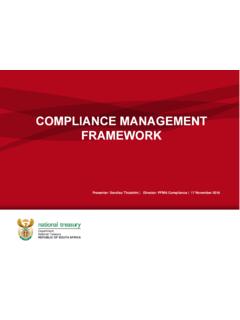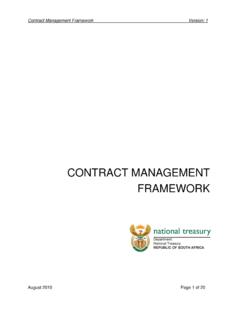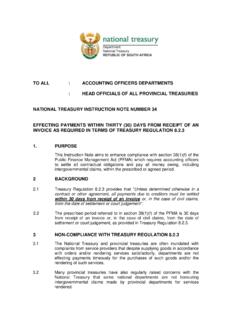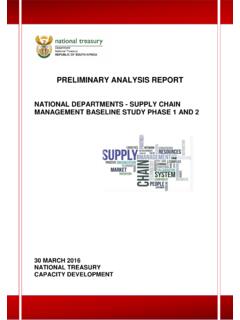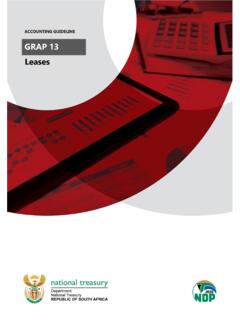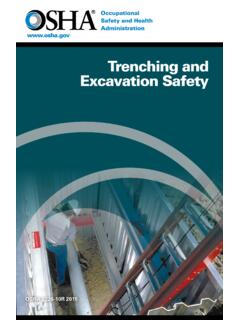Transcription of TECHNICAL COMPETENCY DICTIONARY Explanatory Note
1 TECHNICAL COMPETENCY DICTIONARY . Explanatory Note Immovable Asset Management Introduction The National Treasury has developed a series of TECHNICAL COMPETENCY dictionaries (the COMPETENCY Framework - CFFM) covering the major occupational groups in the field of public financial management. These dictionaries set out a series of descriptions of the skills and knowledge required of a competent practitioner in carrying out a number of standard tasks at various levels of responsibility within the overall function. A total of 10 TECHNICAL competencies dictionaries have been developed with the intention of contributing to human resource development in public financial management. This particular framework deals with the management of immovable assets the stock of fixed assets owned or leased by the government such as buildings, fixed plant and other permanent infrastructure. A separate framework deals with the management of movable assets. Developing the Framework The immovable asset management competencies DICTIONARY was produced following a period of research carried out on behalf of the National Treasury under the Capacity Building Model for Financial Management (CBMFM) project.
2 This research included the following:- PFM related legislation, applicable regulations, instructions and practice notes, national and international standards and guidance on best practice, current practices applied in the workplace. The research was supported by a series of consultative workshops with practitioners, who provided guidance on drafting the competencies, and evaluated and commented on the COMPETENCY statements as they were developed. The attached TECHNICAL COMPETENCY DICTIONARY represents the outcome of that developmental process. However, this DICTIONARY and Explanatory note remain living documents and will continue to be updated in the light of experience as they are used. Any comments on their contents and applicability will be welcomed, and should be submitted to the Capacity Building section of National Treasury. Definition and Scope The management of immovable assets involves all the procedures necessary to ensure that the permanent physical infrastructure of the government is acquired and disposed of efficiently and economically, and utilised and maintained effectively whilst it is in use.
3 Responsibility for carrying out these tasks, however, is divided between experts in infrastructure management (often referred to as public works') such as engineers, architects, maintenance operatives and financial management specialists who deal with the funding and costing aspects. This TECHNICAL competencies DICTIONARY deals only with the role of finance specialists. The DICTIONARY also reflects the fact that the user of immovable assets rests with the departments which use them . 1. the role of the finance specialist is to provide advice, support and TECHNICAL and professional expertise to assist line managers in fulfilling their responsibilities. The major functions performed by asset managers cover the following areas:- strategic financial planning relating to the long-term acquisition, deployment and disposal of immovable assets;. the provision of advice from a financial perspective to line managers about immovable asset management policies and procedures including funding methodologies, and maintenance schedules.
4 Monitoring of the use of immovable assets including physical verification and user asset management plan ( USER-AMP). This DICTIONARY however, deals only with asset management related issues matters pertaining to other financial procedures such as supply chain management, budgeting, accounting and auditing are dealt with in other dictionaries, though a number of competencies in the framework do address aspects of engagement with these functions. The DICTIONARY also excludes consideration of the following:- completion of the infrastructure reporting model (IRM);. any real estate component in public works including;. lease agreements, transfer of immovable assets, expropriation of immovable assets;. immovable assets contracts management, activities dealt with by the Department of Land Affairs. Assumptions The DICTIONARY has been designed on the assumption that financial managers working in national and provincial departments of government are subject to broadly the same working practices and use common IT and other operational systems.
5 At the same time it is recognised that there can be variations in detailed practice between central and provincial administrations, and between individual provincial administrations, so the specifications have been carefully drafted at a level of generality that ensures that such variations have been accommodated. In this DICTIONARY , for example, it is recognised that departments use different approaches to recording immovable assets on an asset register, so the System Maintenance COMPETENCY cluster of the DICTIONARY refers to an electronic immovable asset register (not spreadsheet based) and not manual systems. In some provinces the Department of Public Works maintains the immovable asset register, but the DICTIONARY excludes competencies within such departments (see Definition and Scope above). The Immovable Asset Management DICTIONARY Knowledge and Skills The TECHNICAL competencies DICTIONARY takes the form of a database containing two main elements:- the knowledge (and understanding) required to carry out efficient and effective immovable asset management.
6 2. the skills required to carry out efficient and effective immovable asset management. However, the levels of skill and knowledge required vary substantially according to the level of responsibility of the individual employee in the organisation. To address this, both skills and knowledge descriptions are provided at four different levels. Skills All descriptions of skills required are offered in four tiers (occupational roles) which broadly correspond with the levels of administrative, TECHNICAL , supervisory and managerial responsibilities. Knowledge The actual knowledge required to support any COMPETENCY is the same for all four occupational roles. However, the depth of that knowledge, and the extent of underpinning understanding required varies according to the responsibilities being exercised. Therefore knowledge requirements are also specified at four levels which broadly equate with the descriptions working, TECHNICAL , in-depth and expert. It should be noted that whilst the level of knowledge and understanding specified in the DICTIONARY generally escalates with occupational levels, there are instances where the level of knowledge is not the same as the occupational level ie a greater or lesser depth of knowledge is required than would normally be expected in that occupational role.
7 More comprehensive details are provided in the attached Table 1. The Immovable Asset Management DICTIONARY COMPETENCY Descriptions The knowledge and skills are listed against the principal components of the function. The function is therefore broken down into a series of COMPETENCY clusters which are high-level segments of the function consisting of one or more sub-components. Each cluster is then broken down into these sub-components COMPETENCY titles which are the level at which the definitions of the skills and knowledge are provided. Each definition is supplemented by a COMPETENCY description which summarises the scope of the COMPETENCY defined. Table 2. (attached) contains a list of the COMPETENCY clusters and COMPETENCY descriptions used in this DICTIONARY with an indication in each case of the occupational roles to which they relate. Because of database limitations in the DICTIONARY , general areas of knowledge (such as primary legislation) and other regulations and guidance, some of this knowledge has had to be summarised, so a full statement of the knowledge required under these COMPETENCY titles is set out in attached Table 3.
8 This knowledge is applicable throughout the DICTIONARY and is not normally repeated at the COMPETENCY title level. Knowledge statements at that level relate to more detailed or supplementary knowledge required specifically for that COMPETENCY , and are included in full in the TECHNICAL competencies DICTIONARY . 3. Generic Competencies The TECHNICAL COMPETENCY DICTIONARY deals only with competencies that are specific to tasks in financial management. However, many of the tasks carried out within the function covered in this DICTIONARY require more general competencies of a clerical, administrative or managerial nature. These generic, or core, skills are required for competence in many fields besides financial management, and have therefore been defined in a separate core competencies DICTIONARY . In addition research has identified a number of behavioural competencies which further supplement the TECHNICAL competencies in this DICTIONARY . Bringing all three sets of competencies together will enable government financial managers to identify, understand and articulate clearly the range of skills and attributes needed by staff at all organisational levels for the competent discharge of their responsibilities.
9 Conclusion The Immovable Asset Management COMPETENCY DICTIONARY , along with its nine companion dictionaries, marks a significant step forward for government financial management. Departments may now apply its content to address issues in:- recruitment and selection, staff training and development, performance management, career planning and succession management. 4. Table 1 Definitions of Terms Used in the Immovable Asset Management TECHNICAL Competencies DICTIONARY Description Definition COMPETENCY Cluster High level segment of the function. A short description defining the specific COMPETENCY of the sub- COMPETENCY Title component. COMPETENCY Definition A brief description of the COMPETENCY title. Statement of the skills required within each occupational role and Skills Requirement COMPETENCY title. Specific Knowledge Specific knowledge requirements are noted that are directly Requirement related to a particular COMPETENCY title Knowledge Descriptors Requires a working knowledge with a practical understanding Knowledge Level 1.
10 Applied in straightforward circumstances Requires a working knowledge with a good understanding applied Knowledge Level 2. in circumstances of limited complexity Requires a thorough knowledge with an in-depth understanding Knowledge Level 3. applied in complex circumstances Requires an expert knowledge with a comprehensive Knowledge Level 4. understanding to be applied in highly complex circumstances Role Descriptors Role Descriptors Examples of Relevant Positions Post Levels Role 1. Assistant State Accountant Post levels 1- 6. Administrative Role 2 State Accountant Post levels 7 - 8. TECHNICAL Senior State Accountant Role 3 Assistant Manager Post levels 9 -12. Supervisory (Tactical) Deputy Director ( Manager). Director (Senior Manager). Role 4. Chief Director Post levels 13 -16. Managerial (Strategic). Deputy Director General 5. Table 2 Structure of the Immovable Asset Management TECHNICAL Competencies DICTIONARY COMPETENCY COMPETENCY Occupational Occupational Occupational Occupational Cluster Title Role 1 Role 2 Role 3 Role 4.
